
Полная версия
Falling Upwards
4
Garnerin was replaced, almost at once, by the most justly famous of all the French Revolutionary balloonists. She was a woman – the small, fearless and enigmatic Sophie Blanchard. Born at the sea port of La Rochelle in March 1778, Sophie somehow became involved with the experimental balloonist Jean-Pierre Blanchard, who had first crossed the Channel with Dr Jeffries in 1785, when Sophie was only eight. How their romance began remains a mystery, since Blanchard was already married with children, and spent much of the 1790s touring the cities of Europe and America. But it was rumoured that he first saw her when she was still a child, standing in the crowd at one of his launches, and vowed to return and marry her when she came of age in 1799.
However, the first definite record of them together is not until December 1804, when Blanchard took Sophie on her first balloon flight, above Marseille. According to him she was immediately smitten, breaking her customary painful silence to gasp, ‘Sensation incomparable!’ Pictures show her to be petite and pretty, with large eyes and a dark fringe. But she was also said to be frail and ‘bird-like’, abnormally nervous on the ground, terrified of crowds, loud noises, horses and coach travel, and shy to the point of self-effacement. Yet all this changed completely once she was in the air. In a balloon she became confident and commanding, a natural entertainer and a provoking exhibitionist, daring to the point of recklessness.
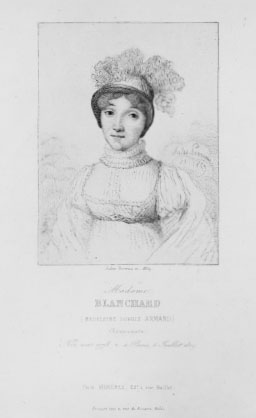
Blanchard, who was ageing and nearly bankrupt, evidently saw the possibilities of reviving his aeronautical career with this fearless young woman, who could instinctively control a balloon, manage aerial fireworks, do acrobatics, and wear eye-catching hats and dresses to please a crowd. He married Sophie when she was twenty-six, and she became his balloon partner for several years, taking over all the arrangements as his health gradually failed. Blanchard died from a heart attack in 1810, while landing in a damaged balloon near The Hague.15 Immediately after his death, Sophie gave her first major solo balloon display in Paris. Like Garnerin, she specialised in night ascents and firework displays, but with much greater daring and eventually recklessness. She deliberately set herself up to rival the other famous female aeronaut of the time, Garnerin’s niece Lisa. Both seemed to vie for official recognition, though Lisa suffered from the waning popularity of the Garnerin name with Napoleon.
Sophie Blanchard seems to have caught the Emperor’s attention during a midsummer ascent from the Champ de Mars in Paris on 24 June 1810. Soon after, she was asked to contribute to the celebration mounted by the Imperial Guard for Napoleon’s marriage to the Archduchess Marie-Louise of Austria. From then on she became a fixture at the imperial court, with propaganda as well as entertainment duties. On the birth of Napoleon’s son in March 1811, she took a balloon flight over Paris from the Champ de Mars and threw out leaflets proclaiming the happy event. She again performed at the official celebration of his baptism at the Château de Saint-Cloud on 23 June, with a spectacular firework display launched from her balloon. In the same year, in an ascent above Vincennes, she climbed so high to avoid being trapped in a hailstorm that she lost consciousness, and spent 14½ hours in the air as a result.
Napoleon now made Sophie’s position official. He appointed her Aéronaute des Fêtes Officielles, a position especially created for her, and gave her responsibility for organising ballooning displays at all major events in Paris. It was also said that he made her his ‘Chief Air Minister of Ballooning’, with secret instructions to draw up plans for an aerial invasion of England. However this seems more like English counter-propaganda, as Napoleon’s idea for an invasion of England had long since been displaced by the ultimately disastrous invasion of Russia, which began in the spring of 1812.
Sophie had by now developed her own peculiar free-style of ballooning. She abandoned her husband’s large canopy and unwieldy basket, both of which were by this time much battered. To replace them she commissioned a much smaller silk balloon, capable of lifting her on a tiny, decorative silver gondola. This was shaped like a small canoe or child’s cradle, curved upwards at each end but otherwise quite open. It was little more than three feet long and one foot high at the sides. One end was upholstered to form a small armchair (in which she sometimes slept), but otherwise the gondola offered astonishingly little protection. When she stood up, grasping the balloon ropes, the edge of the gondola did not reach above her knees. It was virtually like standing in a flying champagne bucket.
She also began to adopt distinctive outfits, which could be seen at a considerable distance. For this purpose her dresses were always white cotton and narrowly cut, with the fashionable English Regency style of high waist and low décolletage. Her sleeves were long, coming right down to her knuckles, presumably to keep her hands warm at high altitudes. Most important of all, she wore a series of white bonnets extravagantly plumed with coloured feathers, to increase her height and visibility. The combined effect of these dramatic clothes and the tiny silver gondola was to make her look both flamboyant and vulnerable. She also appeared terrifyingly exposed, an effect she evidently cultivated.
Sophie now began to give displays in Italy. In the summer of 1811 she took her balloon across the Alps by coach, and celebrated Napoleon’s birthday, the Fête de l’Empereur on 15 August, with an ascent above Milan. She travelled on to Rome with instructions to efface the memory of the unfortunate incident of Nero’s tomb. Here she ascended spectacularly to a height of twelve thousand feet, and stayed aloft all night in her tiny upholstered chair, claiming that she fell into a profound sleep, before landing much refreshed at dawn at Tagliacozzo. She then flew by balloon from Rome to Naples, splitting the journey in half with a stop after sixty miles. She made a daring ascent in bad weather over the Campo Marte in Naples to accompany the review of the troops by Napoleon’s brother-in-law Joachim Murat, the King of Naples.
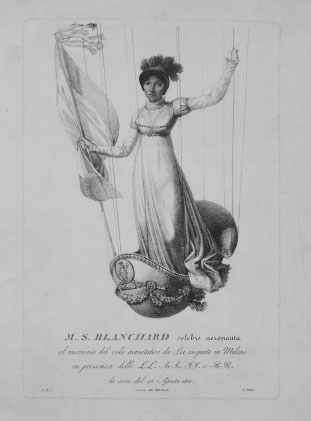
In 1812, the third Aeronautical Exhibition was held at the Champ de Mars. With all eyes on Napoleon advancing towards Moscow, it was not a great success, so Sophie again crossed the Alps with her balloon to make ascents at Turin. On 26 April she flew so high, and the temperature dropped so low, that she suffered a nosebleed and icicles formed on her hands and face.
On her return to Paris, Sophie was surprised to receive a letter on 9 June from André-Jacques Garnerin. He gracefully invited her to dinner at the Hôtel de Colennes to discuss ‘a project that might be of mutual interest’. This probably involved a proposal to make double ascents and parachute drops above the Jardin du Tivoli or the Parc Monceau with her old rival Lisa Garnerin. It is highly unlikely that Sophie would have accepted what she must have regarded as a demeaning and unsuitable proposition.16
The defeat and subsequent exile of Napoleon seemed to pose Sophie Blanchard few problems. When the restored Bourbon king, Louis XVIII, entered Paris for his official enthronement on 4 May 1814, Sophie made a spectacular ascent from the Pont Neuf, with fireworks and Bengal lights. King Louis was so taken with her performance that he immediately dubbed her ‘Official Aeronaut of the Restoration’. Evidently Sophie had no qualms about this shift of political allegiance. Her only loyalty was to ballooning.
Four more years of brilliant public displays followed, with Sophie established as queen of the fireworks night at the Tivoli and Luxembourg Gardens. Her small balloon lifted more and more complicated pyrotechnical rigs, with long booms carrying rockets and cascades, and suspended networks of Bengal lights, all of which she would skilfully ignite with extended systems of tapers and fuses. At the height of these displays, her small white figure and feathery hat would appear like some unearthly airborne creature or apparition, suspended several hundred feet overhead in the night sky, above a sea of flaming stars and coloured smoke.
Towards midnight on 6 July 1819, a hot, overcast summer evening, Sophie Blanchard, aged forty-one, began one of her regular night ascents from the Jardin de Tivoli, accompanied by an orchestra in the bandstand below. At about five hundred feet, and still climbing, she began to touch off her rockets and Bengal lights, dropped little parachute bombs of fizzing gold and silver rain, and ignited a lattice of starshells suspended on wires twenty feet below her gondola. As the gasps and applause of the crowd floated up to her through the darkness, she became aware of a different quality of light burning above her head. Looking up, she saw that the hydrogen in the mouth of her balloon had caught fire. It was amazing that it had never done so before. Many of the crowd thought it was just part of the firework display, and continued to applaud.
The flaming balloon dropped onto the roof of number 16, rue de Provence, near the present Gare Saint-Lazare. The impact largely extinguished the fire. Sophie was not severely burnt, but she was tangled in the balloon rigging. She slid down the roof and caught onto the parapet above the street. Here she hung for a moment, according to eyewitnesses, calmly calling out ‘A moi, à moi!’ Then she fell onto the stone cobbles beneath.
There are numerous accounts of this fiery descent from the Paris sky. They appeared in all the Paris newspapers, and also in English journals like the Gentleman’s Magazine.17 One of the clearest, most poignant descriptions was written by an English tourist, John Poole, who witnessed the event from his hotel room.
I was one of the thousands who saw (and I heard it too) the destruction of Madame Blanchard. On the evening of 6 July 1819, she ascended in a balloon from the Tivoli Garden at Paris. At a certain elevation she was to discharge some fireworks which were attached to her car. From my own windows I saw the ascent. For a few minutes the balloon was concealed by clouds. Presently it reappeared, and there was seen a momentary sheet of flame. There was a dreadful pause. In a few seconds, the poor creature, enveloped and entangled in the netting of her machine, fell with a frightful crash upon the slanting roof of a house in the Rue de Provence (not a hundred yards from where I was standing), and thence into the street, and Madame Blanchard was taken up a shattered corpse! 18
The death of the Royal Aeronaut profoundly changed the reputation of ballooning in France. A public subscription was raised in her honour, but it was found that Sophie Blanchard had no family, and was reported to have left fifty francs in her will ‘to the eight-year-old daughter of one of her friends’ (perhaps an illegitimate child?). So the two thousand francs raised was used to erect a notable balloon monument, which still exists in the 94th Division of Père Lachaise cemetery.fn10
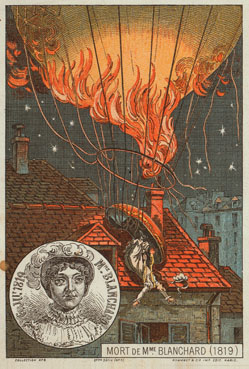

5
Sophie Blanchard’s death in 1819 effectively ended the first great wave of ballomania and the celebration of ballooning in France. Something similar happened in England with the equally shocking death of Thomas Harris five years later. Amazingly, Harris was the first English aeronaut to be killed on home ground. A glamorous young naval officer, he made a much-advertised ascent in his new balloon the Royal George on 24 May 1824. As part of his publicity, he took with him a dazzlingly pretty eighteen-year-old cockney girl, known to the newspapers only as ‘Miss Stocks’, who was generally assumed to be his mistress. Miss Stocks and the balloon, which had cost Harris a thousand guineas to construct, had both been exhibited at the Royal Tennis Court in Great Windmill Street, and stirred much excitement and comment.19
The balloon had a new kind of duplex release valve, which Harris said would allow him and Miss Stocks to make a perfectly controlled landing. One valve was housed inside the other at the top of the balloon. The smaller, inner valve was the conventional safety mechanism, as invented forty years previously by Alexander Charles, designed to release excess gas pressure during flight, or to commence a controlled descent. The larger outer valve was a radical solution to the problem of keeping the balloon safely on the ground once it had landed. When the larger valve line was pulled, it would deflate the entire balloon in a matter of seconds (the equivalent of the ‘rip panel’ in a modern hot-air balloon). This, claimed Harris, would prevent the terrible bouncing and dragging across fields which had caused so many injuries, and so much damage to crops and property (especially chimneys and rooftops) which had undermined the general popularity of balloonists.
Harris circulated a campaigning pamphlet saying that he was trying to save the declining art of ballooning in England. ‘The Science of Aerostation has lately fallen into decay, and has become the subject of Ridicule,’ he lamented. This decline was caused by the ‘total want’ of serious technical inventions by recent aeronauts, who had been content (like that Frenchman Garnerin) to exploit frivolous novelties like parachutes and fireworks. The Royal George, with its new system of valves and its beautiful young passenger, would show the way ahead. In the event it showed something quite else.
Harris took his balloon and Miss Stocks from the West End to the East End to generate further interest, and launched successfully from the large courtyard of the popular Eagle Tavern, in City Road. It was noted that Lieutenant Harris wore his best blue naval uniform, and Miss Stocks a charming dress, much as if they were a honeymoon couple, which perhaps they were. The change in venue was probably made because the wind was blowing south-westwards that day. It took the balloon back across London and the river Thames, an excellent display route, and then on into Kent and towards Croydon. All went well in the basket, champagne was drunk, and Harris then attempted his first perfect display landing at Dobbins Hill, just outside Croydon. However, this did not quite go to plan.
Distracted either by Miss Stocks or by his new duplex valve, he forgot to hang out his grapnel line in time, and was forced to throw out ballast to avoid colliding with some nearby trees. This was by no means a disastrous error, but it evidently rather flustered Harris. The balloon rose several hundred feet in the air, and was carried on over Beddington Park, on the other side of Croydon. Here Harris evidently prepared for a second attempt at a landing.
The swift sequence of events that followed has remained a matter of dispute ever since. For no accountable reason, the Royal George suddenly began to descend from several hundred feet ‘with fearful velocity’. As it dropped, it was claimed by witnesses that some kind of struggle was briefly observed in the basket. The partially deflated balloon plummeted ‘with frightful rapidity’ into a large oak tree in the park, tore through the light spring foliage (it was only May) and dashed its passengers to the ground. ‘They were shortly afterwards discovered, buried beneath a monumental pile of silk and network.’ Both of them were outside the basket, but while Thomas Harris was dead, Miss Stocks was alive and conscious, though quite unable to give a coherent account of what had occurred during the last few seconds.
What had destroyed the balloon seemed obvious to the coroner. The new large gas valve – ‘the preposterous aperture’ – had been released prematurely. The coroner ascribed this to Harris’s fatal error in pulling the wrong valve line while still in the air. Later aeronauts, like Charles Green, analysed the sequence of events more subtly. Green suggested that Harris’s only error was to have tied the larger valve line to a point in the basket, precisely to keep it safe and out of the way, especially with Miss Stocks aboard. However it had pulled itself taut – ‘a longitudinal extension of the apparatus’ – when the balloon contracted, thereby unexpectedly and fatally releasing the deflation valve by itself. This was a kindly, if ingenuous, explanation, which did not quite square with the evidence that Miss Stocks gave afterwards: ‘Miss Stocks declares that she distinctly heard the peculiar sound which always accompanies the shutting of the valve, as soon as Mr Harris had let go the line.’ This sounds as if Harris had indeed pulled the line himself, and realising his error, had let it go too late. But of course, Miss Stocks could have meant ‘as soon as Mr Harris had untied the line’.20
The much larger question, and the one that made ‘le mort de Harris’ a cause célèbre in France, was a more human mystery. Why did Miss Stocks survive when Lieutenant Harris died? The disposition of the bodies gave little clue, both presumably having been thrown from the basket on impact. But the suggestion almost inevitably arose that the gallant Harris had somehow saved the beautiful Miss Stocks.
British commentators were brusque about this mystery ‘that has hitherto clouded the event’, and gave romantic explanations short shrift. Most probably, a branch of the oak tree, ‘projecting horizontally’, had protected Miss Stocks (though unfortunately not Harris). Just possibly Miss Stocks ‘had fainted, and fallen forward … upon the body of Mr Harris’. Thereby he had unintentionally protected her from ‘the first violence’ of the impact. Anything else pandered to ‘false and scurrilous reports’.21
French journalists were more liberal in their interpretations. Lieutenant Harris and Miss Stocks could have been distracted ‘in many ways’, so that the wrong valve line was pulled. Lieutenant Harris would surely have tried to protect Miss Stocks with his body during the terrifying descent, ‘if not before’. But most likely of all, and the real reason for her survival, was that Lieutenant Harris ‘in a spirit of admirable chivalry’ had leapt from the balloon basket before the moment of impact, in a quixotic attempt to reduce the speed of her fall.22 It was a gesture of true English gallantry from a true English naval officer. The romantic image of Lieutenant Harris leaping from the balloon to save his beloved became an iconic one in France, and featured alongside images of the death of Pilâtre de Rozier and Sophie Blanchard in a famous series of French balloon cards. They marked the end of an era.
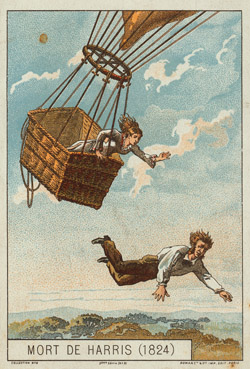
The growing scepticism about the future of ballooning was summed up by the satirical artist George Cruikshank. In his brilliant coloured cartoon of 1825 entitled ‘Balloon Projects’, he depicted a row of gaudily striped balloons tethered down the length of St James’s, like a rank of hackney cabs waiting for hire. A fashionable couple are about to climb gingerly into one of them (with pink plush upholstery), to embark on a ‘one shilling’ flight from Mayfair to the City. Each balloon car is manned by a suitably villainous driver, one of whom is shouting to another, ‘I say, Tom, give my balloon a feed o’ gas, will you!’
Above them the sky is filled with a mass of grotesquely shaped balloons, one in the form of a hogshead of beer, another with a weathercock on top, and a third on fire with its passengers leaping out. Behind them all the buildings are advertising balloon companies and businesses, which is probably the real point of Cruikshank’s satire. These dubious establishments include ‘The Balloon Life Assurance Company’, ‘The Bubble Office’, ‘The Office of the Honourable Company of Moon Rakers’, and perhaps most ingeniously, ‘The Balloon Eating House – Bubble & Squeak Every Day’.23
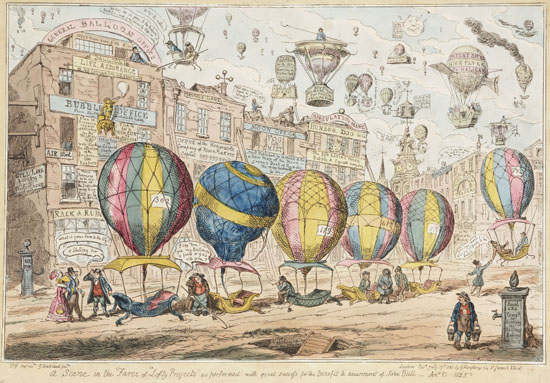
The historical painter Benjamin Robert Haydon, friend of John Keats and Charles Lamb, who kept a close if disillusioned eye on London freaks and fashions from his studio near Baker Street, noted grimly in his diary for 6 June 1825: ‘No man can have a just estimation of the insignificance of his species, unless he has been up in an air-balloon.’
Of course, not everyone was so disillusioned. A remarkable balloon is featured in Jane Loudon’s extraordinary science fiction novel The Mummy! A Tale of the Twenty-First Century (1827). It was written when Loudon was aged twenty, ‘a strange, wild novel’, as she herself called it, full of totally unexpected technical inventions, such as ‘steam percussion bridges’, heated streets, mobile homes on rails, smokeless chemical fuels, electric hats (for ladies), and most spectacularly a full-size balloon made from a nugget of highly concentrated Indiarubber. Small enough to be stored in a desk drawer, such a ‘portable’ balloon once inflated is large enough carry three people from Britain to Egypt.24
Loudon’s description of an aerial balloon carnival is brilliantly prophetic of modern balloon fiestas, especially the more psychedelic American ones: ‘The air was thronged with balloons, and the crowd increased at every moment. These aerial machines, loaded with spectators till they were in danger of breaking down, glittered in the sun, and presented every possible variety of shape and colour. In fact, every balloon in London or the vicinity had been put into requisition, and enormous sums paid, in some cases, merely for the privilege of hanging to the cords which attached to the cars, whilst the innumerable multitudes that thus loaded the air, amused themselves by scattering flowers upon the heads of those who rode beneath.’ The fantastic balloon shapes include, for more sportive individuals, ‘aerial horses, inflated with inflammable gas’, and for the more languid, ‘aerial sledges’ which can be flown from a supine position.25
3
Airy Kingdoms
1
By the end of the 1820s the early pioneering days were over, and the dream of some universal form of global air transport by navigable balloons had faded across Europe.
Indeed, quite another form of revolutionary transport system was starting to emerge, in the shape of the railway network. The opening of the twenty-six miles of the Stockton to Darlington line in 1825 heralded an era of universal railway building. Five years later, the first genuine passenger service opened between Manchester and Liverpool. From then on, the heavy engineering of the Victorian steam engine, establishing powerful new notions of speed, reliability and a regular ‘time-table’ came to dominate the whole concept of travel.
These weighty considerations were, of course, the exact opposite of what a hydrogen balloon could provide. Victorian ballooning would eventually become the antithesis of the Victorian railway. It would be seen as poetic as against prosaic; as natural rather than man-made. The Victorian railway would mean iron, steam, noise, power and speed, as Turner envisaged in his painting. It would bring ‘railway time’, and a form of mass transport which was both a vital means and a literary symbol of industrialisation. By contrast, ballooning would come to be seen as essentially bucolic, even pastoral. It was silent, decorative, exclusive, and refreshingly unreliable: a means to mysterious adventure rather than a mode of mundane travel.1 fn11
So, at this very time of the railway boom, a new kind of flying was starting to capture people’s imagination. It was marked by the emergence of what might be called the ‘recreational’ balloon. These were increasingly large, sophisticated and well-equipped aerostats, designed to take several paying passengers, and with luck to make a profit for their owners. Though they were commercial propositions, they retained an ineffable romance. They often had ‘royal’ in their names, in deference to the new young Queen Victoria, who came to the throne in 1837.









